| Construction Rating: | starstarstarstarstar |
| Flight Rating: | starstarstarstarstar |
| Overall Rating: | starstarstarstarstar |
| Manufacturer: | LOC/Precision  |
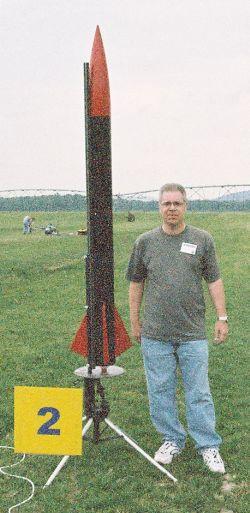
Brief:
The Big Nuke-3E is one of the newer Loc/Precision kits designed by Barry Lynch.
The clean styling and mach fin design of the Big Nuke-3E is based on the
classic PK-4 Lil' Nuke featured in the 2" kit line.
Construction:
The kit is shipped in a large, well packed box with a label with the kit name
and a picture of the kit pasted on the outside of the box. I'm sure the Big
Nuke-3E label must have caught the eye of the delivery drivers because it made
it all the way from Al's Hobby Shop in Elmhurst, IL to Louisiana without a
scratch or dent on it.
Here is the parts list:
- 1 payload section, 24" long
- 1 main airframe, 34" long
- 2 shock cords (tubular nylon, loops pre-sewn 24' long)
- 1 plastic nose cone
- 1 main 75mm motor mount tube, 23"long
- 1 bulkhead plate assembly
- 1 shock cord mount centering ring
- 2 main centering rings
- 2 shock cord mount hardware sets (quicklinks, eye bolts, nuts, and washers)
- 2 parachutes (58" main and 18" drogue)
- 1 fin set (1/4" plywood)
- 2 1/2" launch lugs
- 1 fin guide
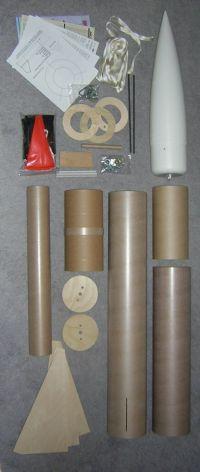
Also included was a 4 page color brochure of LOC/Precision kits (April 2002), LOC/Precision price list one page front and back, an EB-5.38 electronics bay kit and assembly instructions, and the assembly instructions for the BIG NUKE-3E (one page front and back).
Printed on the front side of the assembly instructions card are the kit specs and features with the same picture of the Big Nuke-3E used on their website. It states "75mm motor mount version with electronics bay" because there is also a shorter Big Nuke kit version that has a 2" motor mount and is supplied without the electronics bay. Since LOC/Precision kits do not have recommended skill levels, you will also find on the instructions card: "this kit is recommended for those with previous model rocket building experience".
The Big Nuke-3E is a straightforward build, just follow the step-by-step procedures and it actually goes together pretty quickly. Twenty one step-by-step procedures are outlined in a logical order on the back side of the card for assembly. Step 12 has a note before it: "If using the optional electronics bay assembly, skip this step and follow the instructions provided with the assembly". Step 12 looks like the standard bulkhead assembly procedure for any LOC kit that comes with a payload section so I assume this set of instructions could also be used to build the standard Big Nuke kit and therefore the note before step 12.
The fin guide pattern card has a drawing for fin alignment with a rear view diagram showing proper placement as well as an illustration showing an exposed side view of centering ring/motor mount tube assembly and fin placement.
It is recommended to test fit parts before bonding together with epoxy. It is also recommended to use epoxy throughout the entire construction due to the high thrust motors that can be used in this kit. All the parts did fit together nicely but with the high humidity here in Louisiana, I did have to peel a small layer off of the electronics bay tube coupler to get it to fit well inside of the airframe tubes. Sanding may be necessary before you start construction.
Everyone has their own personal preference for epoxy and I'm no different. I feel that instead of thickening laminating epoxy with a filler, a paste adhesive should be used for bonding and high strength fillets. I used both AeroPoxy ES6220 fast setting liquid epoxy adhesive for general parts bonding and ES6279 high strength non-metal filled epoxy adhesive paste for the centering rings, motor mount, fins and fillets.
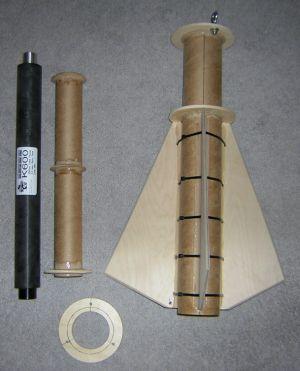 I did
deviate from the instructions on the steps to bond the centering rings and fins
to the motor mount tube by peeling the outer glassine layer entirely off the
motor mount tube first and then tack bond those parts with the fast setting
adhesive followed by fillets with the paste adhesive. The paste is about the
consistency of peanut butter and stays where you put it with no run off so
everything can be bonded at once and with one mixed paste batch. I traced the
fin guide onto foam board and cut slots and a circle for the airframe to pass
through for accurate fin alignment. I also drilled a few small holes in the
fins where the airframe would cover them and used nylon cable ties to hold the
fins to the motor tube for better bonding. No fiberglass reinforcement was used
and it is not recommended by the instructions included with this kit. Stock Big
Nuke-3E kits have been flown successfully many times on the maximum recommended
motors according to Barry Lynch.
I did
deviate from the instructions on the steps to bond the centering rings and fins
to the motor mount tube by peeling the outer glassine layer entirely off the
motor mount tube first and then tack bond those parts with the fast setting
adhesive followed by fillets with the paste adhesive. The paste is about the
consistency of peanut butter and stays where you put it with no run off so
everything can be bonded at once and with one mixed paste batch. I traced the
fin guide onto foam board and cut slots and a circle for the airframe to pass
through for accurate fin alignment. I also drilled a few small holes in the
fins where the airframe would cover them and used nylon cable ties to hold the
fins to the motor tube for better bonding. No fiberglass reinforcement was used
and it is not recommended by the instructions included with this kit. Stock Big
Nuke-3E kits have been flown successfully many times on the maximum recommended
motors according to Barry Lynch.
I jumped out of the assembly order of the kit one time and decided to build the electronics bay last. The electronics bay housed a single PerfectFlite miniAlt/WD and a 9 volt battery on the included plywood sled. I used a single RadioShack SPST push-on/off switch (part #275-617) mounted through a hole drilled into the plywood sled and aligned the center of the switch with one of the vent holes to operate it through the vent hole with a screwdriver. With the switch mounted to the sled, the entire sled and altimeter can be removed easily and plugged into the serial cable at the computer to download the flight data. I purchased extra 1/4-20 nuts for the electronics bay threaded rod to help position the sled inside the bay vertically since the sled and sled lugs are shorter than the length of the bay. The sled could move the alignment of the switch with the vent hole up or down. On each bulkhead plate I externally mounted a NIBCO #4718 CPVC bushing, size 3/4" x 1/2". These can be purchased at Home Depot and are the perfect size diameter for the QuickBurst EZ small ejection canisters to make a snug fit. Just bond the bushing to the bulkhead plate and drill a small 1/8" hole in the bulkhead plate for the ejections canisters wires to pass through the center of the bushing and connect directly to the terminals on the miniAlt/WD. This eliminated the need for terminal blocks mounted on the outside of each bulkhead plate and also helped to avoid another possible point of recovery failure due to the terminal block connections and additional wiring that would have been required. I wanted to keep this entire assembly as simple as possible and most of this step of the build is left to the builder's planning and experience and is therefore not fully detailed in the instructions. No correct or incorrect way of doing this, just whatever works for you!
 I also
built a motor mount adapter from a 17" section of LOC/Precision 54mm motor
mount tubing, 2 LOC CR-3.00-2.14 centering rings and 1 LOC CR-3.9-2.14
centering ring for a back plate. The 54mm motor I had planned to use would be
longer than the motor mount tube and could be retained from the top and bottom
with masking tape since the adapter is removable. Three blind nuts were
installed into the rear centering ring prior to kit construction and fender
washers, screws and nuts used for standoffs retain the rear CR-3.9-2.14
centering ring of the motor mount adapter against the aft centering ring of the
rocket.
I also
built a motor mount adapter from a 17" section of LOC/Precision 54mm motor
mount tubing, 2 LOC CR-3.00-2.14 centering rings and 1 LOC CR-3.9-2.14
centering ring for a back plate. The 54mm motor I had planned to use would be
longer than the motor mount tube and could be retained from the top and bottom
with masking tape since the adapter is removable. Three blind nuts were
installed into the rear centering ring prior to kit construction and fender
washers, screws and nuts used for standoffs retain the rear CR-3.9-2.14
centering ring of the motor mount adapter against the aft centering ring of the
rocket.
I decided to use a pair of BlackSky #2051 acetal rail guides instead of the provided launch lugs. I drilled and screwed these directly into the fore and aft plywood centering rings and bonded them with epoxy. I did this solely because it is my experience that it's much easier to find a launch rail not in use than it is a launch rod at most launches.
Finishing:
No special requirements or techniques as far as finishing the rocket. I used
Kilz white sealer/primer spray for the fins and sanded smooth. I waited a few
days and I painted the fins and nose cone with Krylon red fusion paint for
plastics, waited a week, masked the fins, and painted all of the airframe
tubing with Krylon flat black. Krylon markets the Fusion paint as the no prep,
super bond paint for plastic. In hindsight I would just use the standard Krylon
paints and save the money. Even with proper washing to remove the mold release
from the plastic nose cone, I found the Fusion paint really doesn't adhere any
better than the less expensive standard Krylon paints even when following the
application instructions to the letter. The finished rocket looked good and the
rating for construction is also top notch.
Construction Rating: 5 out of 5
Photo credit: Tom
Binford
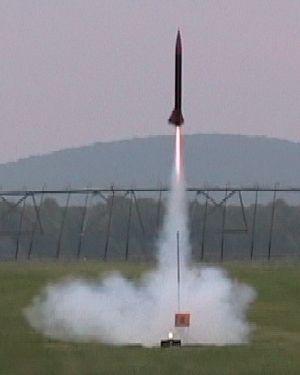
Flight:
The LOC/Precision website recommends this rocket can be flown on any I, J, K,
or L class motor. There are flyers that have used this rocket to obtain their
Tripoli Level 3 cert using an Ellis Mountain M1000 (although not recommended by
the rocket's manufacturer). My finished Nuke weighed in at 9.6 lbs without a
motor.
I had purchased an Ellis Mountain single use K600 with the hopes of flying the Big Nuke with that motor at this years Southern Thunder 2005 launch in Manchester, TN, but it hadn't passed the TRA motor certification test yet. I purchased a Cesaroni Pro54 K570 for my first flight from Ken at Al's Hobby Shop at a very discounted price. Flight preparation took about 30 minutes. I attached shock cords, tied off parachutes, rigged ejection charges, set altimeter switches and wiring, and did the motor assembly at the Southern Thunder flying field the morning of my first flight. Since the Pro54 case has a thrust ring built into the aft end, I slid it into the motor mount adapter I made and retained it on the top side with 2" wide masking tape. I then slid the adapter and motor into the 3" motor mount on the rocket and retained the adapter with 3 fender washers and bolted it in. No wadding was required because I used a Nomex® chute protector for both the drogue and main parachutes. Cesaroni supplies an electric match with the reload kit so I installed it according to the instructions. Motor ignition was quick and the K570 turns on at about 200 pounds of thrust and gave a very fast boost with some weathercocking due to winds associated with a front moving into the area that morning. The motor could still be heard under thrust as it pushed through some low cloud cover and out of sight.
Photo credit: Dale
Fountain
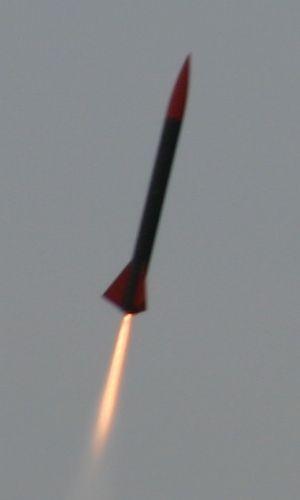
Recovery:
The rocket drifted completely out of the flying field, over a tree line, and
was recovered about 1.25 miles from where I launched it. Many other K powered
and L3 flight attempts followed the same recover path right out of the field
due to the winds that morning.
Many thanks to Russ Bruner and his buddy with the White Jeep for picking up my rocket while searching for his own L3 that drifted into the same area. I also want to thank Paul Yarnold, PHFD for tracking the flight with his range finder binoculars and to Ken Herrick of Al's Hobby Shop for all of the motor and construction suggestions he gave me for building such a fine rocket.
Flight Rating: 5 out of 5
Summary:
PROs: LOC/Precision kits are heavy duty with many high quality kit components
and Barry Lynch has done a fine job with the design of the Big Nuke-3E kit. The
electronics bay is well engineered and easy to assemble and adapt to your
needs.
CONs: None.
Overall Rating: 5 out of 5
Other Reviews
- LOC/Precision Big Nuke-3E By Michael Schneider
Brief: This kit was modified sightly for level 3 certification flight with dual deployment with the SkyAngle Cert-3 24" drogue to pull the SkyAngle Cert-3 main chute from the deployment bag at 1,200 feet. Construction: This is one of Barry Lynch's great kits with some up grades for M powered flights. The kit includes: 1 5.38" LOC BT paper tube, 45" long 1 ...
 |
 |
Flights
 |
 |
 |
 |
J. .E. (May 24, 2009)